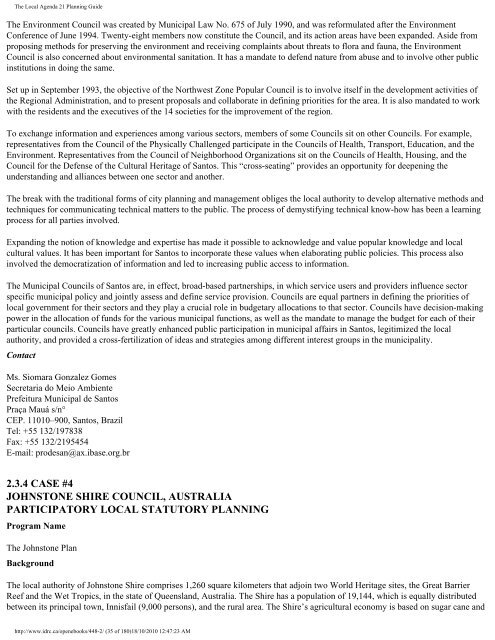The Local Agenda 21 Planning Guide - Democrats Against UN ...
The Local Agenda 21 Planning Guide - Democrats Against UN ...
The Local Agenda 21 Planning Guide - Democrats Against UN ...
You also want an ePaper? Increase the reach of your titles
YUMPU automatically turns print PDFs into web optimized ePapers that Google loves.
<strong>The</strong> <strong>Local</strong> <strong>Agenda</strong> <strong>21</strong> <strong>Planning</strong> <strong>Guide</strong><br />
<strong>The</strong> Environment Council was created by Municipal Law No. 675 of July 1990, and was reformulated after the Environment<br />
Conference of June 1994. Twenty-eight members now constitute the Council, and its action areas have been expanded. Aside from<br />
proposing methods for preserving the environment and receiving complaints about threats to flora and fauna, the Environment<br />
Council is also concerned about environmental sanitation. It has a mandate to defend nature from abuse and to involve other public<br />
institutions in doing the same.<br />
Set up in September 1993, the objective of the Northwest Zone Popular Council is to involve itself in the development activities of<br />
the Regional Administration, and to present proposals and collaborate in defining priorities for the area. It is also mandated to work<br />
with the residents and the executives of the 14 societies for the improvement of the region.<br />
To exchange information and experiences among various sectors, members of some Councils sit on other Councils. For example,<br />
representatives from the Council of the Physically Challenged participate in the Councils of Health, Transport, Education, and the<br />
Environment. Representatives from the Council of Neighborhood Organizations sit on the Councils of Health, Housing, and the<br />
Council for the Defense of the Cultural Heritage of Santos. This “cross-seating” provides an opportunity for deepening the<br />
understanding and alliances between one sector and another.<br />
<strong>The</strong> break with the traditional forms of city planning and management obliges the local authority to develop alternative methods and<br />
techniques for communicating technical matters to the public. <strong>The</strong> process of demystifying technical know-how has been a learning<br />
process for all parties involved.<br />
Expanding the notion of knowledge and expertise has made it possible to acknowledge and value popular knowledge and local<br />
cultural values. It has been important for Santos to incorporate these values when elaborating public policies. This process also<br />
involved the democratization of information and led to increasing public access to information.<br />
<strong>The</strong> Municipal Councils of Santos are, in effect, broad-based partnerships, in which service users and providers influence sector<br />
specific municipal policy and jointly assess and define service provision. Councils are equal partners in defining the priorities of<br />
local government for their sectors and they play a crucial role in budgetary allocations to that sector. Councils have decision-making<br />
power in the allocation of funds for the various municipal functions, as well as the mandate to manage the budget for each of their<br />
particular councils. Councils have greatly enhanced public participation in municipal affairs in Santos, legitimized the local<br />
authority, and provided a cross-fertilization of ideas and strategies among different interest groups in the municipality.<br />
Contact<br />
Ms. Siomara Gonzalez Gomes<br />
Secretaria do Meio Ambiente<br />
Prefeitura Municipal de Santos<br />
Praça Mauá s/n°<br />
CEP. 11010–900, Santos, Brazil<br />
Tel: +55 132/197838<br />
Fax: +55 132/<strong>21</strong>95454<br />
E-mail: prodesan@ax.ibase.org.br<br />
2.3.4 CASE #4<br />
JOHNSTONE SHIRE CO<strong>UN</strong>CIL, AUSTRALIA<br />
PARTICIPATORY LOCAL STATUTORY PLANNING<br />
Program Name<br />
<strong>The</strong> Johnstone Plan<br />
Background<br />
<strong>The</strong> local authority of Johnstone Shire comprises 1,260 square kilometers that adjoin two World Heritage sites, the Great Barrier<br />
Reef and the Wet Tropics, in the state of Queensland, Australia. <strong>The</strong> Shire has a population of 19,144, which is equally distributed<br />
between its principal town, Innisfail (9,000 persons), and the rural area. <strong>The</strong> Shire’s agricultural economy is based on sugar cane and<br />
http://www.idrc.ca/openebooks/448-2/ (35 of 180)18/10/2010 12:47:23 AM










